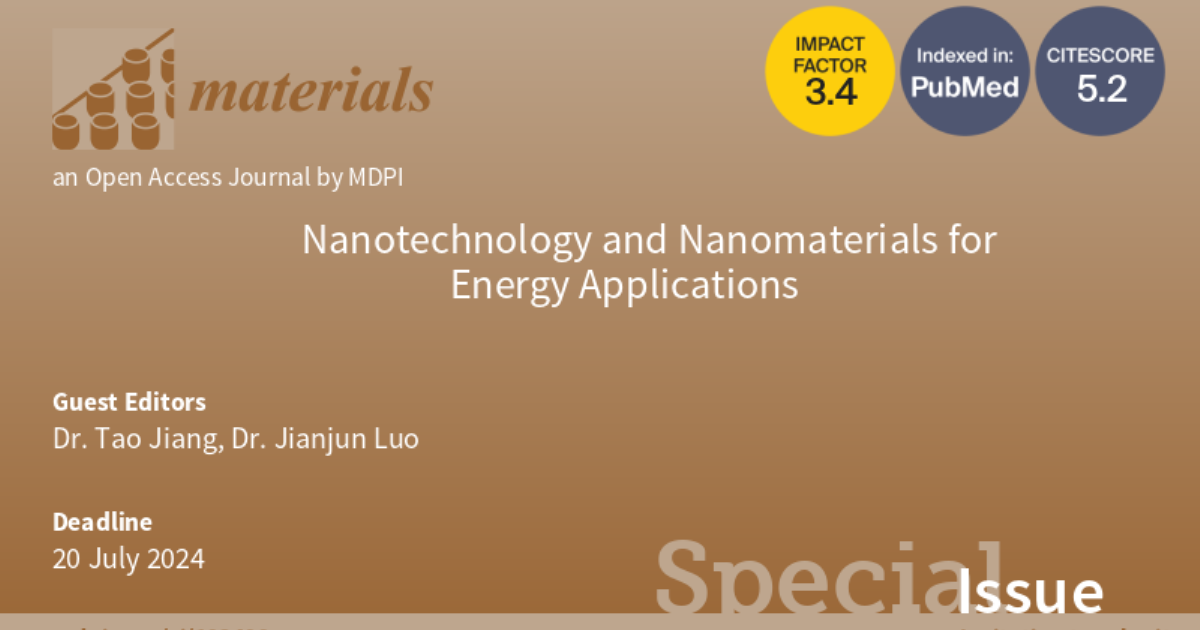Nanotechnology and Nanomaterials for Energy Applications
A special issue of Materials (ISSN 1996-1944). This special issue belongs to the section "Advanced Nanomaterials and Nanotechnology".
Deadline for manuscript submissions: 20 July 2024 | Viewed by 423

Special Issue Editors
2. School of Nanoscience and Engineering, University of Chinese Academy of Sciences, Beijing 100049, China
Interests: triboelectric nanogenerators; blue energy harvesting; power management; self-powered systems
Special Issues, Collections and Topics in MDPI journals
2. School of Nanoscience and Engineering, University of Chinese Academy of Sciences, Beijing 100049, China
Interests: triboelectric nanogenerators; energy harvesting; self-powered sensing; intelligent sports
Special Issues, Collections and Topics in MDPI journals
Special Issue Information
Dear Colleagues,
Under the dual pressures of global ecological environment deterioration and an increasing shortage of traditional fossil energy, utilizing renewable energy has become an important energy strategy for every country in the hopes of achieving social sustainability. Harvesting renewable energies from our ambient environments through the development of novel smart nanomaterials and micro/nanoscale energy technologies is of great practical significance. The emergence of nanogenerators, which can effectively harvest the environmental mechanical energy needed to generate electricity, provides a promising route to sustainable energy. The rapid development of nanogenerator technologies has gradually improved our understanding of energy harvesting. Also, new smart nanomaterials with new nanostructures need to be explored for nanogenerator systems in order to enhance the output performance and efficiency of nanogenerators.
This Special Issue on “Nanotechnology and Nanomaterials for Energy Applications” aims to cover recent achievements in the fields of novel nanomaterial fabrication and characterization as well as nanotechnology applications in environmental energy harvesting and self-powered systems.
Dr. Tao Jiang
Dr. Jianjun Luo
Guest Editors
Manuscript Submission Information
Manuscripts should be submitted online at www.mdpi.com by registering and logging in to this website. Once you are registered, click here to go to the submission form. Manuscripts can be submitted until the deadline. All submissions that pass pre-check are peer-reviewed. Accepted papers will be published continuously in the journal (as soon as accepted) and will be listed together on the special issue website. Research articles, review articles as well as short communications are invited. For planned papers, a title and short abstract (about 100 words) can be sent to the Editorial Office for announcement on this website.
Submitted manuscripts should not have been published previously, nor be under consideration for publication elsewhere (except conference proceedings papers). All manuscripts are thoroughly refereed through a single-blind peer-review process. A guide for authors and other relevant information for submission of manuscripts is available on the Instructions for Authors page. Materials is an international peer-reviewed open access semimonthly journal published by MDPI.
Please visit the Instructions for Authors page before submitting a manuscript. The Article Processing Charge (APC) for publication in this open access journal is 2600 CHF (Swiss Francs). Submitted papers should be well formatted and use good English. Authors may use MDPI's English editing service prior to publication or during author revisions.
Keywords
- novel nanomaterials
- nanomaterial fabrication and characterization
- nanotechnology applications
- environmental energy harvesting
- nanogenerators
- self-powered systems







